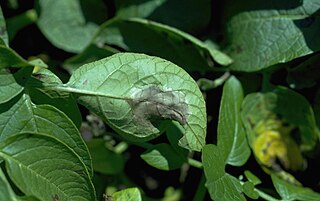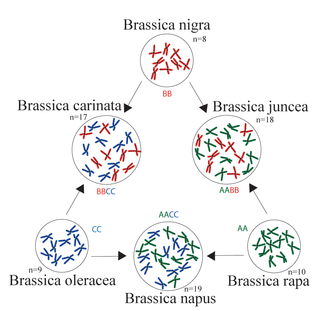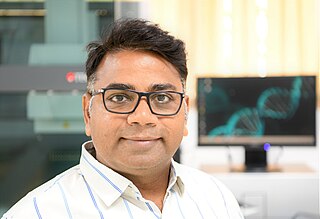Biography
Khan was born in a small village called Tahlian in Pallandri, Azad Kashmir (the Pakistani-administered part of the disputed Jammu and Kashmir region) and was from a humble financial background. His primary-level education was at a "taat school," where the students sat on a jute mat (taat) on the ground and he also helped his parents raise crops and livestock. [2]
He earned a PhD from the Swiss Federal Institute of Technology (ETH), Zurich, Switzerland on fire blight of apples, and an MSc from Georg-August University, Gottingen, Germany, with further research experience at the University of York, UK and University of Illinois, Urbana-Champaign, United States. [1] [2]
He has published in several high impact scientific journals including Science, Nature Genetics, and Genome Research. [5] His research on rapid decline of apple trees, fire blight, genetics, and genomics of apples has been also highlighted in popular magazines, including Science Magazine, The Economist, New York Times, and Forbes. [6] [7] [8] [2] In 2022, Dr. Khan co-led a research and completed a chromosome-scale genome sequence assembly of Honeycrisp apples. [9] [10]

Phytophthora infestans is an oomycete or water mold, a fungus-like microorganism that causes the serious potato and tomato disease known as late blight or potato blight. Early blight, caused by Alternaria solani, is also often called "potato blight". Late blight was a major culprit in the 1840s European, the 1845–1852 Irish, and the 1846 Highland potato famines. The organism can also infect some other members of the Solanaceae. The pathogen is favored by moist, cool environments: sporulation is optimal at 12–18 °C (54–64 °F) in water-saturated or nearly saturated environments, and zoospore production is favored at temperatures below 15 °C (59 °F). Lesion growth rates are typically optimal at a slightly warmer temperature range of 20 to 24 °C.

Genome projects are scientific endeavours that ultimately aim to determine the complete genome sequence of an organism and to annotate protein-coding genes and other important genome-encoded features. The genome sequence of an organism includes the collective DNA sequences of each chromosome in the organism. For a bacterium containing a single chromosome, a genome project will aim to map the sequence of that chromosome. For the human species, whose genome includes 22 pairs of autosomes and 2 sex chromosomes, a complete genome sequence will involve 46 separate chromosome sequences.
A quantitative trait locus (QTL) is a locus that correlates with variation of a quantitative trait in the phenotype of a population of organisms. QTLs are mapped by identifying which molecular markers correlate with an observed trait. This is often an early step in identifying the actual genes that cause the trait variation.

The triangle of U is a theory about the evolution and relationships among the six most commonly known members of the plant genus Brassica. The theory states that the genomes of three ancestral diploid species of Brassica combined to create three common tetraploid vegetables and oilseed crop species. It has since been confirmed by studies of DNA and proteins.
Rebecca J. Nelson is an American biologist and a professor at Cornell University and a MacArthur Foundation Fellow.

Malus sieversii is a wild apple native to the mountains of Central Asia in southern Kazakhstan. It has recently been shown to be the primary ancestor of most cultivars of the domesticated apple. It was first described as Pyrus sieversii due to its similarities with pears in 1833 by Carl Friedrich von Ledebour, a German naturalist who saw them growing in the Altai Mountains.

Steven Dale Tanksley is the Chief Technology Officer of Nature Source Improved Plants. Prior to founding Nature Source Improved Plants, Tanksley served as the Liberty Hyde Bailey professor of plant breeding and biometry and chair of the Genomics Initiative Task Force at Cornell University College of Agriculture and Life Sciences. He is currently a Professor Emeritus at Cornell University.

Cytochrome b is a protein that in humans is encoded by the MT-CYB gene. Its gene product is a subunit of the respiratory chain protein ubiquinol–cytochrome c reductase, which consists of the products of one mitochondrially encoded gene, MT-CYB, and ten nuclear genes—UQCRC1, UQCRC2, CYC1, UQCRFS1, UQCRB, "11kDa protein", UQCRH, Rieske protein presequence, "cyt c1 associated protein", and Rieske-associated protein.

Transcription factor MafB also known as V-maf musculoaponeurotic fibrosarcoma oncogene homolog B is a protein that in humans is encoded by the MAFB gene. This gene maps to chromosome 20q11.2-q13.1, consists of a single exon and spans around 3 kb.

AT-rich interactive domain-containing protein 2 (ARID2) is a protein that in humans is encoded by the ARID2 gene.

The interleukin-23 receptor is a type I cytokine receptor. It is encoded in human by the IL23R gene. In complex with the interleukin-12 receptor β1 subunit (IL-12Rβ1), it is activated by the cytokine interleukin 23 (IL-23). The IL23R mRNA is 2.8 kilobases in length and includes 12 exons. The translated protein contains 629 amino acids; it is a type I penetrating protein and includes a signal peptide, an N-terminal fibronectin III-like domain and an intracellular part that contains three potential tyrosine phosphorylation domains. There are 24 IL23R splice variants in mitogen-activated lymphocytes. IL23R includes some single-nucleotide polymorphisms in the region encoding the domain that binds IL-23, which may lead to differences between people in Th17 activation. There is also a variant of IL-23R that consists of just the extracellular part and is known as soluble IL-23R. This form can compete with the membrane-bound form to bind IL-23, modulating the Th17 immune response and regulation of inflammation and immune function.
Expression quantitative trait loci (eQTLs) are genomic loci that explain variation in expression levels of mRNAs.
In statistical genetics, inclusive composite interval mapping (ICIM) has been proposed as an approach to QTL mapping for populations derived from bi-parental crosses. QTL mapping is based on genetic linkage map and phenotypic data to attempt to locate individual genetic factors on chromosomes and to estimate their genetic effects.

Rajeev Kumar Varshney is an Indian agricultural scientist, specializing in genomics, genetics, molecular breeding and capacity building in developing countries. Varshney is currently serving as Director, Western Australian State Agricultural Biotechnology Center; Director, Centre for Crop & Food Innovation; and International Chair in Agriculture & Food Security with the Food Futures Institute at Murdoch University, Australia since Feb 2022. Before joining Murdoch University, Australia he served International Crops Research Institute for the Semi-Arid Tropics (ICRISAT), a global agriculture R&D institute, for more than 16 years in different scientific and research leadership roles including Research Program Director for three global research programs– Grain Legumes, Genetic Gains and Accelerated Crop Improvement Program. He has the onus of establishing and nurturing the Center of Excellence in Genomics & Systems Biology (CEGSB), a globally recognized center for genomics research at ICRISAT that made impacts on improving agriculture and development of human resources in several countries including India, China, Kenya, Ethiopia, Tanzania, Nigeria, Ghana, Mali, Senegal, Burkina Faso, etc. Varshney holds Adjunct/Honorary/Visiting Professor positions at 10 academic institutions in Australia, China, Ghana, Hong Kong and India, including The University of Western Australia, University of Queensland, West Africa Centre for Crop Improvement, University of Hyderabad, Chaudhary Charan Singh University and Professor Jayashankar Telangana State Agricultural University.
In molecular biology mir-367 microRNA is a short RNA molecule. MicroRNAs function to regulate the expression levels of other genes by several mechanisms.
In molecular biology mir-396 microRNA is a short RNA molecule. MicroRNAs function to regulate the expression levels of other genes by several mechanisms.
A diversity panel is a collection of genetic material or individual samples taken from a diverse population of a certain species. The idea is to illustrate the genetic and phenotypic diversity of the species.
Kang Zhang is a Chinese-American ophthalmologist specializing in ophthalmic genetics and aging processes in the eye. He is currently a Professor of the Faculty of Medicine at Macau University of Science and Technology. He was previously a Professor of Ophthalmology and the Founding Director of the Institute for Genomic Medicine at the University of California, San Diego. Zhang is particularly known for his work on lanosterol, stem cell research, gene editing, and artificial intelligence.
Solynta is a Dutch biotechnology company that specializes in hybrid potato breeding. It is headquartered in Wageningen, Gelderland, the Netherlands.










